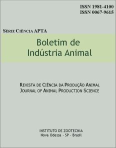Model of sanitary management for the eradication of bovine herpesvirus 1 (HVB-1) in a dairy herd
Keywords:
sanitary management, vaccination, eradication, Bovine Herpesvirus type 1Abstract
This paper describes the efficacy of sanitary management on the eradication of HVB- 1 by means of hyperimmunization, that consists in infected animals vaccination in order to decrease the level of viral reactivation in carriers. Seroneutralization in microplates was the technique used for HVB-1 diagnosis in a dairy herd bred extensively. In the first year of the studies the occurrence of seroreagents older than six month old was 44.5% (166/373). After that, other evaluations were performed in non-reagents cows and calves. From the second year on, hyperimmunization was performed every six months on seropositive animals older than six months of age, using the inactivated monovalent vaccine with oily adjuvant. The greatest occurrence of seroreagents was observed in older animals in productive and reproductive phases. The rate of seroreagents decreased with the gradual culling of these animals, and three years after the establishment of the sanitary program, the number of seroreagents decreased to zero. In the first year, incidence was equal to 0.5% (2/371), in the second year, 0.8% (3/387), and was zero in the third year. Calves born from seroreagent cows became non-reagent after the disappearance of colostral immunity. Annual reduction in the number of reagent animals was due to the culling of seropositive females, substituted by non-reagent heifers. Fight against HVB-1 by monitoring non-reagent individuals, hyperimmunization and progressive culling of seroreagents, associated with other prophylactic procedures, such as the use of virus-free semen and animal traffic control made gradual culling of infected animals a rational procedure until eradication was completed.
Downloads
Downloads
Published
Issue
Section
License
Os autores não serão remunerados pela publicação de trabalhos, pois devem abrir mão de seus direitos autorais em favor deste periódico. Por outro lado, os autores ficam autorizados a publicar seus artigos, simultaneamente, em repositórios da instituição de sua origem, desde que citada a fonte da publicação original seja Boletim de Indústria Animal. A revista se reserva o direito de efetuar, nos originais, alterações de ordem normativa, ortográfica e gramatical, com vistas a manter o padrão culto da língua e a credibilidade do veículo. Respeitará, no entanto, o estilo de escrever dos autores. Alterações, correções ou sugestões de ordem conceitual serão encaminhadas aos autores, quando necessário. Nesses casos, os artigos, depois de adequados, deverão ser submetidos a nova apreciação. As opiniões emitidas pelos autores dos artigos são de sua exclusiva responsabilidade. Todo o conteúdo deste periódico, exceto onde está identificado, está licenciado sob a Licença Creative Commons Attribution (CC-BY-NC). A condição BY implica que os licenciados podem copiar, distribuir, exibir e executar a obra e fazer trabalhos derivados com base em que só se dão o autor ou licenciante os créditos na forma especificada por estes. A cláusula NC significa que os licenciados podem copiar, distribuir, exibir e executar a obra e fazer trabalhos derivados com base apenas para fins não comerciais.













